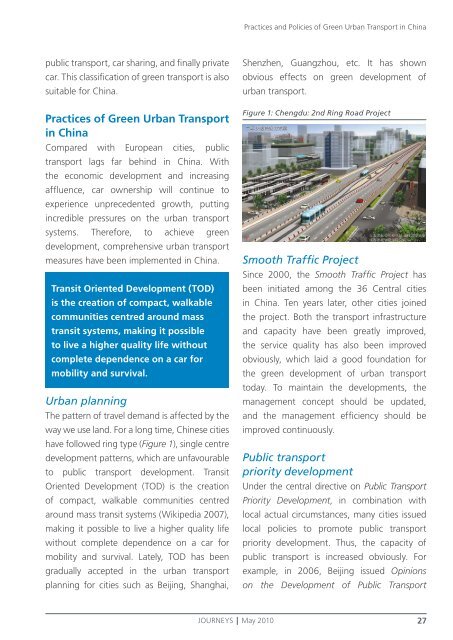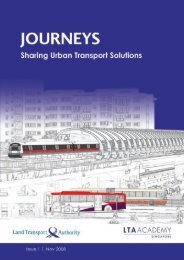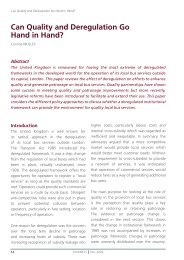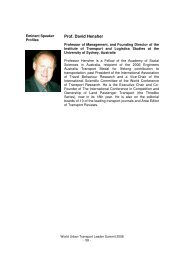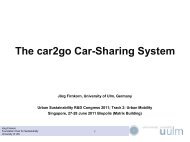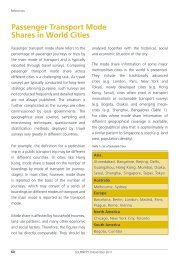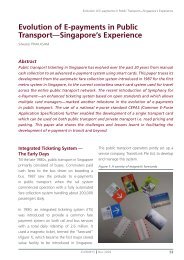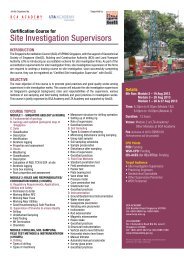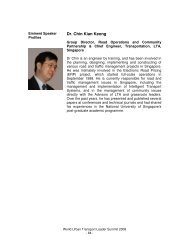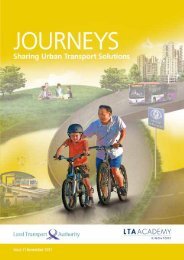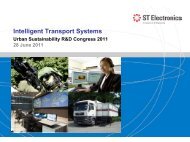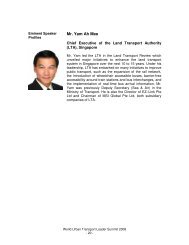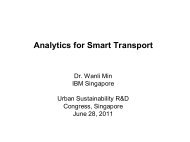Issue 4 May 2010 - LTA Academy
Issue 4 May 2010 - LTA Academy
Issue 4 May 2010 - LTA Academy
You also want an ePaper? Increase the reach of your titles
YUMPU automatically turns print PDFs into web optimized ePapers that Google loves.
public transport, car sharing, and finally private<br />
car. This classification of green transport is also<br />
suitable for China.<br />
Practices of Green Urban Transport<br />
in China<br />
Compared with European cities, public<br />
transport lags far behind in China. With<br />
the economic development and increasing<br />
affluence, car ownership will continue to<br />
experience unprecedented growth, putting<br />
incredible pressures on the urban transport<br />
systems. Therefore, to achieve green<br />
development, comprehensive urban transport<br />
measures have been implemented in China.<br />
Transit Oriented Development (TOD)<br />
is the creation of compact, walkable<br />
communities centred around mass<br />
transit systems, making it possible<br />
to live a higher quality life without<br />
complete dependence on a car for<br />
mobility and survival.<br />
Urban planning<br />
The pattern of travel demand is affected by the<br />
way we use land. For a long time, Chinese cities<br />
have followed ring type (Figure 1), single centre<br />
development patterns, which are unfavourable<br />
to public transport development. Transit<br />
Oriented Development (TOD) is the creation<br />
of compact, walkable communities centred<br />
around mass transit systems (Wikipedia 2007),<br />
making it possible to live a higher quality life<br />
without complete dependence on a car for<br />
mobility and survival. Lately, TOD has been<br />
gradually accepted in the urban transport<br />
planning for cities such as Beijing, Shanghai,<br />
Practices and Policies of Green Urban Transport in China<br />
Shenzhen, Guangzhou, etc. It has shown<br />
obvious effects on green development of<br />
urban transport.<br />
Figure 1: Chengdu: 2nd Ring Road Project<br />
Smooth Traffic Project<br />
Since 2000, the Smooth Traffic Project has<br />
been initiated among the 36 Central cities<br />
in China. Ten years later, other cities joined<br />
the project. Both the transport infrastructure<br />
and capacity have been greatly improved,<br />
the service quality has also been improved<br />
obviously, which laid a good foundation for<br />
the green development of urban transport<br />
today. To maintain the developments, the<br />
management concept should be updated,<br />
and the management efficiency should be<br />
improved continuously.<br />
Public transport<br />
priority development<br />
Under the central directive on Public Transport<br />
Priority Development, in combination with<br />
local actual circumstances, many cities issued<br />
local policies to promote public transport<br />
priority development. Thus, the capacity of<br />
public transport is increased obviously. For<br />
example, in 2006, Beijing issued Opinions<br />
on the Development of Public Transport<br />
JOURNEYS <strong>May</strong> <strong>2010</strong> 27


